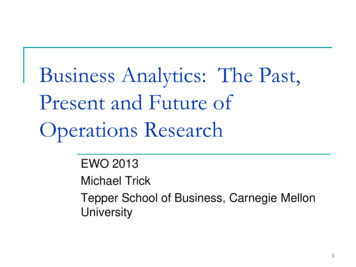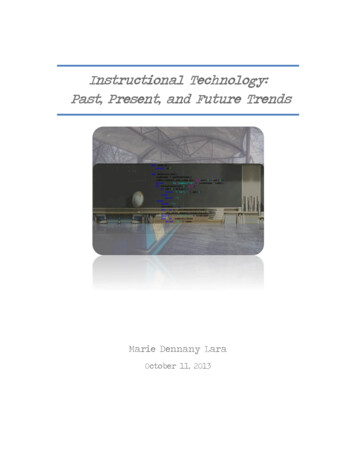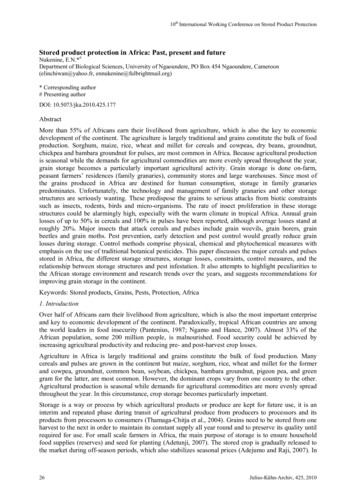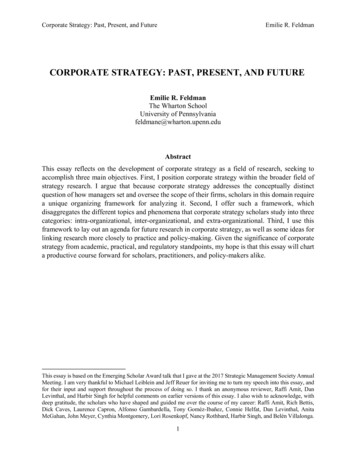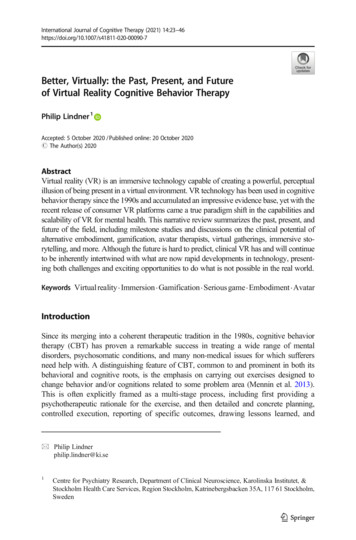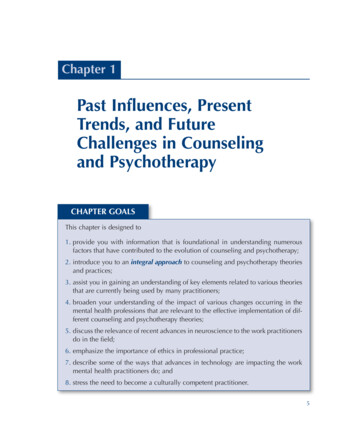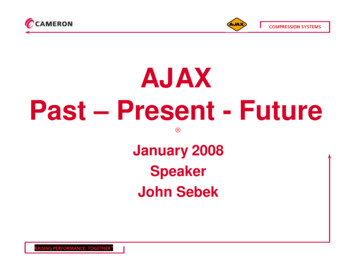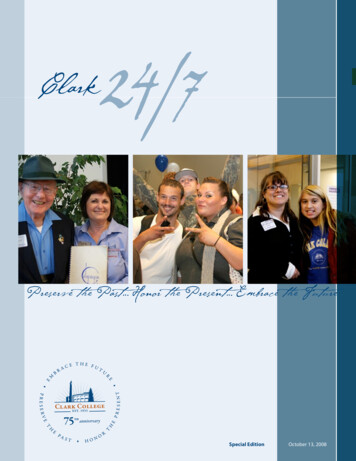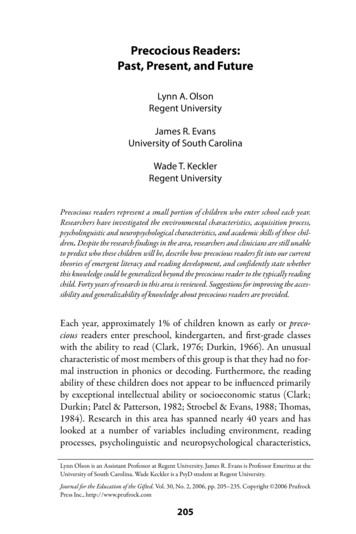
Transcription
Precocious Readers:Past, Present, and FutureLynn A. OlsonRegent UniversityJames R. EvansUniversity of South CarolinaWade T. KecklerRegent UniversityPrecocious readers represent a small portion of children who enter school each year.Researchers have investigated the environmental characteristics, acquisition process,psycholinguistic and neuropsychological characteristics, and academic skills of these children. Despite the research findings in the area, researchers and clinicians are still unableto predict who these children will be, describe how precocious readers fit into our currenttheories of emergent literacy and reading development, and confidently state whetherthis knowledge could be generalized beyond the precocious reader to the typically readingchild. Forty years of research in this area is reviewed. Suggestions for improving the accessibility and generalizability of knowledge about precocious readers are provided.Each year, approximately 1% of children known as early or precocious readers enter preschool, kindergarten, and first-grade classeswith the ability to read (Clark, 1976; Durkin, 1966). An unusualcharacteristic of most members of this group is that they had no formal instruction in phonics or decoding. Furthermore, the readingability of these children does not appear to be influenced primarilyby exceptional intellectual ability or socioeconomic status (Clark;Durkin; Patel & Patterson, 1982; Stroebel & Evans, 1988; Thomas,1984). Research in this area has spanned nearly 40 years and haslooked at a number of variables including environment, readingprocesses, psycholinguistic and neuropsychological characteristics,Lynn Olson is an Assistant Professor at Regent University. James R. Evans is Professor Emeritus at theUniversity of South Carolina. Wade Keckler is a PsyD student at Regent University.Journal for the Education of the Gifted. Vol. 30, No. 2, 2006, pp. 205–235. Copyright 2006 PrufrockPress Inc., http://www.prufrock.com205
206Journal for the Education of the Giftedand academic skills. Despite the amount of research, the phenomenaremains elusive. This article intends to provide a thorough literaturereview of what we know about precocious reading abilities, as well asthe recommended direction of future research.Definition of Early ReadersAs with many other psychological phenomena, the literature does notprovide a universal definition or set of guidelines for identifying precocious readers. Close examination of the research, however, revealsthat, to a greater or lesser degree, researchers acknowledge three coreconcepts as features of precocious readers. First, and most obviously,the very young child must demonstrate ability to decode words. Theability to decode has been diversely operationalized. Some researchers used less rigorous and objective definitions. For instance, Anbar(1986) considered a youngster an early reader if he or she was able toread six simple sentences consisting of three to five words; comprehension was never assessed. Other researchers specified a criterion level ofreading ability based on norm-referenced, standardized measures ofword recognition (Burns & Collins, 1987; Clark, 1976).Second, in order to rule out hyperlexia, the ability to decodewithout comprehension, a majority of researchers required that children also demonstrate comprehension of written material. Whilesome researchers presumed any degree of comprehension is synonymous with reading (e.g., Anbar, 1986), others required that childrenperform at a given criterion level using norm-referenced measuresof reading ability (Durkin, 1966; Plessas & Oakes, 1964; Stroebel& Evans, 1988; Thomas, 1984). Many researchers who used normreferenced reading tests defined precocious reading as the ability todecode and comprehend items at or above the second-grade level forpreschoolers (Plessas & Oakes; Stroebel & Evans; Thomas).Finally, several research studies also considered the role ofinstruction in reading acquisition as an important element in defining precocious reading. Some studies exclude those who have participated in “formal” or systematic reading instruction (Salzer, 1984;Teale, 1978). Throughout the literature, the concept of formal
Precocious Readers207instruction is diversely operationalized. Most researchers categorizeinstruction as formal if it occurred within a structured school environment but acknowledge that most early readers in their studiesreceived some sort of informal instruction from parents, caregivers,or siblings (Durkin, 1966). Inspection of past research identified awide variety of informal means used to facilitate reading among subjects. Some instructional methods were described as “spontaneous,intuitive, and unplanned” (Anbar, 1986, p. 78). In general, this typeof help tended to be more responsive and less directive than formalinstruction, and descriptive accounts indicated that children apparently learned to read because of their ability to ask the right questions rather than being directly taught (Clark, 1976; Torrey, 1969).Other informal types of help have been more structured and consistof reading kits, preprimers, association of letters and sounds, use ofpicture dictionaries, alphabet games, flash cards, and teaching soundsof letters (Burns & Collins, 1987; Plessas & Oakes, 1964). Whatappeared common among research findings, with the exception ofa study by Briggs and Elkind (1977), was that the help providedby parents, siblings, and caregivers most often was initiated by thechild’s demonstration of reading ability rather than the desire of thehelper to initiate reading skills development (Clark; Torrey, 1969).It should be noted, however, that it is possible that more formal reading instruction was provided. Most of the information was gatheredthrough interviews with parents and none of the above-mentionedstudies asked the children how they learned to read. It is likely thatretrospective, subjective reports provided by parents do not providean accurate account of how the child actually learned to read.Psychological Aspects of Precocious ReadersDurkin (1966) pioneered the first large-scale study of precociousreading ability and investigated reading, intellectual, and environmental correlates of two groups of early readers, one from New Yorkand one from California. Much of the research in the area has followed her model and can be divided into three general categories:descriptions of the personal and environmental correlates of early
208Journal for the Education of the Giftedreaders, the process of early reading, and the academic and psycholinguistic skills of the precociously reading child.General and Environmental Characteristics of Precocious ReadersIndividual Characteristics. Research identified and investigated anumber of individual characteristics hypothesized to be correlatesor possible causal factors of precocity. Intelligence represents onesuch characteristic. While Cox (1926) and Gross (2004) report thatmany gifted children are reading at early ages, research investigating precocious readers indicates that an average to superior level ofintelligence may be a necessary accompaniment of early reading butdoes not guarantee spontaneous reading skill. That is, many gifted,but nonprecociously reading, preschoolers require formal instruction before they begin to read (Burns & Collins, 1987; Clark, 1976;Torrey, 1969). Most between-group studies found average to superior full scale IQ, with reported mean or median levels often in thesuperior range of intelligence (Burns, Collins, & Paulsell, 1991;Durkin, 1966; Patel & Patterson, 1982; Thomas, 1984). IQ scoresof subjects of these studies are found in Table 1. Single case studies ofprecocious readers also reported a range of intellectual skills, but themajority reported superior levels of intelligence (Krippner, 1963;Lass, 1983; Pennington, Johnson, & Welsh, 1987).In addition to intellectual skills, a number of researchers investigatedpersonality correlates of precocious readers. Among these studies, allrelied on parental interview data to describe personality characteristicsof early readers (Durkin, 1966; Salzer, 1984; Thomas, 1984) rather thanobjective measures of personality traits, such as child behavioral checklists. In her first studies, Durkin found that parents of her Californiagroup described their children as more “persistent,” “perfectionistic,”“curious,” “competitive,” and having a “good memory.” These results werenot replicated with her New York group where parental descriptions ofcharacteristics did not differentiate readers from nonreaders. Likewise,Salzer, using qualitative analysis of both direct observation of structuredand unstructured parent-child and examiner interactions and interviewdata collection procedures, found no consistent personality factorsamong early readers. During interviews performed by Thomas, mothers
241113323249301921972331202056WISC-R*Stanford BinetStanford BinetWPPSIStanford BinetStanford BinetSlossonWPPSIWISC-RStanford BinetLorge-Thorndike Intelligence TestWISCWISCMcCarthyBackman, 1983Burns et al., 1991Caldwell, 1985Clark, 1976Clark, 1976Durkin, 1966 (CA)Durkin, 1966 (NY)Evans & Smith, 1976Stroebel & Evans, 1988Jackson & Biemiller, 1985; Jackson et al., 1988Jackson & Myers, 1982King & Friesen, 1972Patel & Patterson, 1982Plessas & Oakes, 1964Thomas, 1984Note. aBased on subtest score with a mean of 10 and a standard deviation of 3. *Not reported.NMeasureAuthorMean ummary of Intelligence Levels of Precociously Reading ChildrenTable 1Median IQScore*****121133********Precocious Readers209
210Journal for the Education of the Giftedof early readers tended to use more “cognitive/creative” words, such as“positive” and “intellectual,” to describe their children, while parents ofnonreaders used more “emotional/social” descriptors to describe theirchildren. Hence, no consistent personality correlates of early readershave been identified. The failure to identify common correlates mayreflect the use of subjective and open-ended means of gathering data, orit may suggest that early readers are a heterogeneous group of childrenwho share exceptional reading skills.Investigations of play or toy preferences have failed to identifyconsistent play patterns among early readers. Durkin (1966) foundthat early readers enjoyed solitary and quiet play. Thomas (1984)found that readers enjoyed more reading readiness toys while nonreaders enjoyed a diversity of toys throughout early childhood. Briggsand Elkind (1977), however, found no differences in preferences fortoys among readers and nonreaders.Some researchers identified the amount of television watched byearly readers as a variable of interest, but, again, few have found consistent patterns among early readers. Durkin (1966) found that precocious readers tended to watch television less than 6 hours per week.Other researchers, however, reported that the children watched upto 2 hours per day (Briggs & Elkind, 1973; Plessas & Oakes, 1964).Like the amount of television watched, reported television preferences also varied across studies. Durkin (1966) found that theprecociously reading children in her study did not prefer nurseryschool-kindergarten type programs (e.g., “Sesame Street,” “The ElectricCompany,” etc.) but preferred commercials, quiz programs, and weatherprograms. Other researchers reported that many early readers preferrededucational-type programs with some watching a particular show upto four times per day (Salzer, 1984). Jackson, Donaldson, and Cleland(1988) found that a majority of precocious readers whose parentsresponded to their questionnaire started watching educational programs before the age of 2 years (81% watched “Sesame Street” and 67%watched the “The Electric Company” before 2 years). Although someresearchers found no differences among readers and nonreaders in theamount of time spent watching “Sesame Street” (Briggs & Elkind, 1973;Thomas, 1984), Briggs and Elkind (1973) reported that early readerswatched “The Electric Company” significantly more than nonreaders.
Precocious Readers211Environmental Factors. Researchers have also investigated a numberof environmental factors as possible correlates of early reading abilities. For example, socioeconomic status has been studied. Researchhas not supported socioeconomic status as a primary factor associated with early reading skills regardless of whether father’s occupation or parental educational level is considered. Studies of earlyreaders have indicated that a variety of socioeconomic backgroundsare represented among precocious readers. Among her two groups(California and New York), Durkin (1966) found that early readers emanated from blue collar families in the California group, butwere more evenly distributed among upper lower, lower, middle,and upper middle classes in the New York study. A few researchers reported that mothers of early readers had higher educationallevels and socioeconomic standing (Briggs & Elkind, 1973, 1977;Durkin). Other researchers found that early readers were from midrange socioeconomic status (Anbar, 1986; Patel & Patterson, 1982).In a qualitative analysis of 40 early readers, Plessas and Oakes (1964)found that these children often came from families who were clerical or professional workers. However, most between-group studiesof readers and nonreaders found no differences between the twogroups on socioeconomic variables such as income and father’soccupation (Thomas, 1984). The fact that socioeconomic factorsplay such a minimal role in precocious reading is surprising; moststudies in the field of giftedness overall usually find socioeconomicstatus to be a significant factor in the development of gifted children(Konstantopoulos, Modi, & Hedges, 2001).Durkin (1966) had hypothesized that socioeconomic statuswould interact with parents’ attitudes toward early reading. Accordingto Durkin, however, failure to find a relationship between socioeconomic status and early reading abilities may not be a reflection ofsocioeconomic status alone but may represent a change among middle-class attitudes toward accepting and encouraging early reading.Other researchers posited that parental attitude toward educationmay influence a child’s ability more than either parental income orfather’s occupational status (Clark, 1976). No other studies, however, have investigated parental attitude toward early reading as apossible contributor to early reading skills.
212Journal for the Education of the GiftedA few studies investigated parental characteristics such as readinghabits. These researchers reported that one or both parents of earlyreaders considered themselves avid readers (Durkin, 1966; Krippner,1963; Teale, 1978). The modeling provided by parents may have provided an impetus for their child(ren)’s interest in reading.Among the home-environment factors investigated, manyresearchers have examined the child’s interaction with reading materials as a possible factor affecting early reading acquisition. Takentogether, the studies identified a number of ways children can interact with reading materials. First, several studies indicated that parents and/or siblings read to the precocious reader regularly, manyon a daily basis (Anbar, 1986; Briggs & Elkind, 1973; Clark, 1976;Durkin, 1966; Krippner, 1963; Plessas & Oakes, 1964; Stainthorp& Hughes, 2004b; Stroebel & Evans, 1988). Some were read toseveral times per day (Plessas & Oakes). In studies where a controlgroup was used, early readers were read to more often than nonprecocious readers (Briggs & Elkind, 1973; Stroebel & Evans). Briggsand Elkind (1973) found that fathers of readers read to their children significantly more than fathers of nonreaders.Second, some research has indicated that these children areexposed to a variety of reading material (Brenna, 1995; Teale,1978). In several of the investigative studies, researchers found thatparents provided their children with a number of children’s booksfrom which to read (Clark, 1976; Durkin, 1966; Krippner, 1963;Stainthorp & Hughes, 2004b; Torrey, 1969). In one study, parentsof readers took their children to the library more often than parents of nonreaders (Briggs & Elkind, 1977). Books, however, werenot the only modality of reading provided. Children used their earlyreading ability in a number of other situations. For instance, childrencommonly showed interest in print found on common householdobjects and other environmental stimuli such as signs, cereal boxes,and products on TV (Clark; Durkin; Krippner; Torrey).Third, early readers in those studies frequently showed interest inwritten material by displaying interest in writing skills (Teale, 1978).Several studies indicated that these children’s interests and abilitiesin reading coincided with a desire to write. Durkin (1966), Clark
Precocious Readers213(1976), and Plessas and Oakes (1964) all indicated that early readersshowed a desire to write and print by copying letters and numbers.Fourth, one research study investigated the social-linguistic environment of early readers. Davidson and Snow (1995) used a qualitativeanalysis to perform a between-group comparison of the social interactions of parents and their children. Six early readers were matched tosix nonearly readers by age, sex, and receptive vocabulary. Variablesof interest included language complexity, conversational devices,and topic. Children’s decontextualized language was also assessed.Complexity referred to the mean length of the utterance and themean length of the turn. Conversational devices referred to the speakers’ roles and included inquiries, clarification, information, explanation, and topic initiations. Decontextualized language was assessed byrequesting definitions of a group of nouns (e.g., knife, diamond), aswell as requesting procedural descriptions (e.g., how to play checkers).Results indicated that parents of precocious readers provided a morechallenging and rich linguistic environment for their children thandid parents of nonprecociously reading children. Fathers, in particular, provided more complex speech patterns. Differences in the children’s use of decontextualized language showed that early readers weresuperior at providing procedural descriptions but not in providingdefinitions. While the results suggest that early readers have a richerlinguistic environment, the authors recognized the need for furtherresearch to determine whether the richer environment was a cause ofor consequence of the children’s reading ability.Finally, and possibly one of the most important factors correlated with early reading, is the parents’ ability and desire to respondto their child’s ability. Brenna (1995) noted that parents providedindirect support by spending time with their children, playing, andtalking, which provided role modeling of oral and written languageskills. Furthermore, several researchers noted parents’ response tothe child’s questions regarding letters, words, and spelling when thechild needed that help as a primary contributor to the child’s reading ability (Brenna; Clark, 1976; Durkin, 1966; King & Friesen,1972; Krippner, 1963; Plessas & Oakes, 1964). In Brenna’s qualitative investigation of the parent-child interaction, she reported thatparents encouraged early readers to use a variety of problem-solving
214Journal for the Education of the Giftedstrategies and tended to “go with the child’s common strategies” (p.59) as the primary means of facilitating progress. According to Teale(1978), parental responsiveness provides children immediate feedback based on the child’s interest.In summary, despite the number of general and environmentalfactors investigated, none of the factors (intellectual, personality,or environmental) appear to provide a definitive explanation forthe exceptional reading ability of these
Regent University James R. Evans University of South Carolina Wade T. Keckler Regent University Precocious readers represent a small portion of children who enter school each year. researchers have investigated the environmental characteristics, acquisition process,
